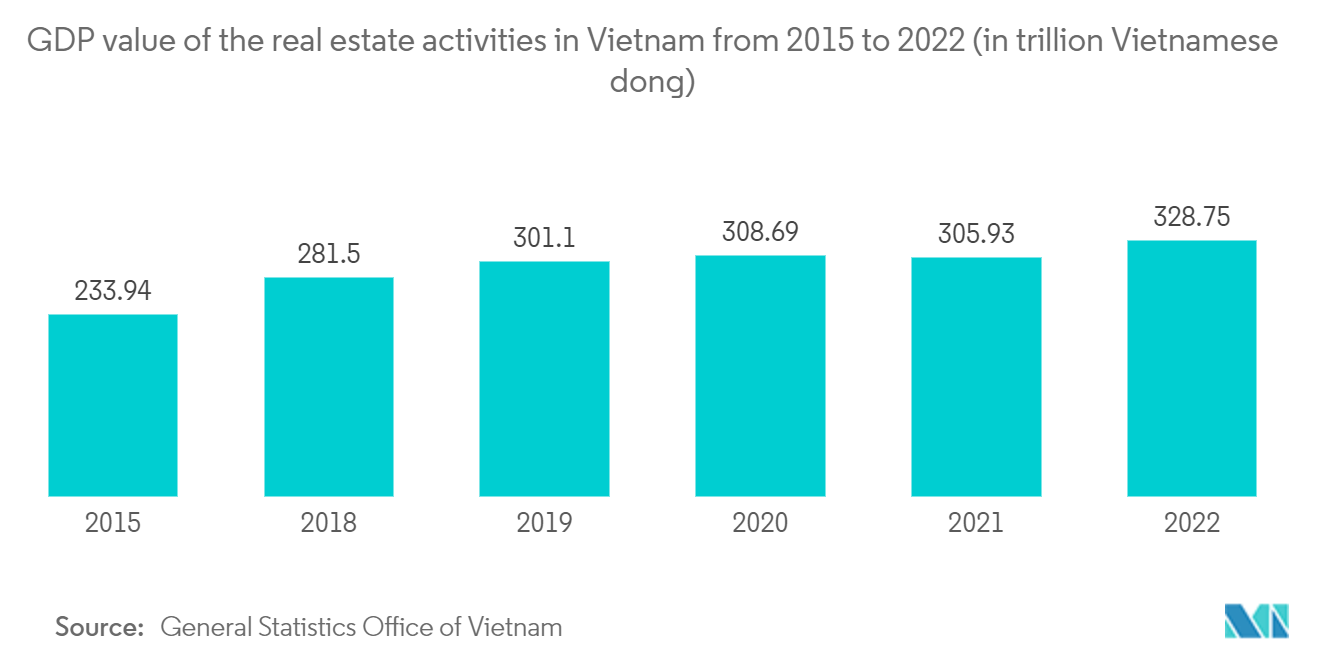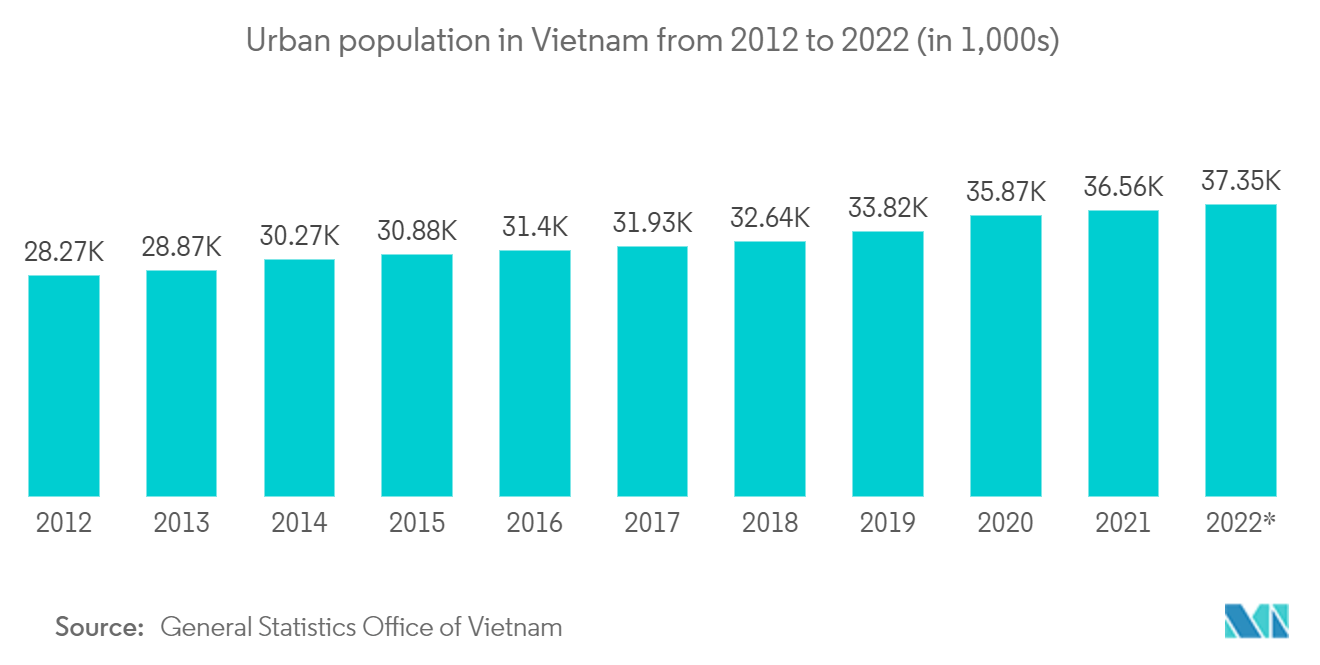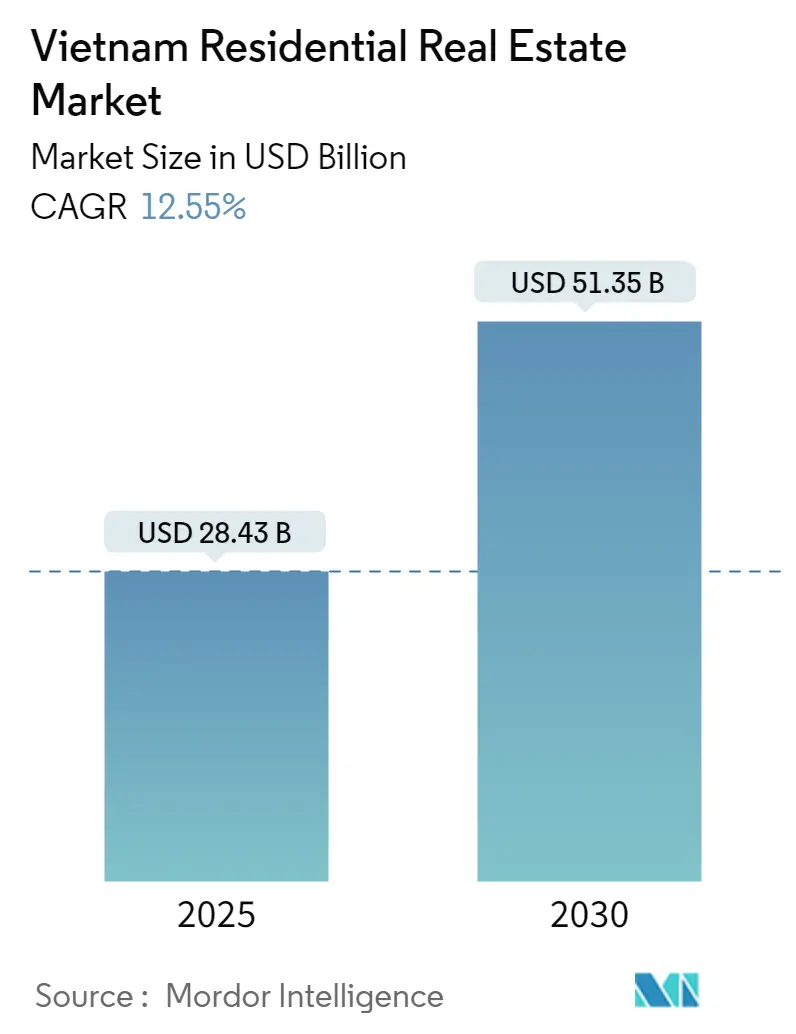
| Study Period | 2020 - 2030 |
| Base Year For Estimation | 2024 |
| Forecast Data Period | 2025 - 2030 |
| Market Size (2025) | USD 28.43 Billion |
| Market Size (2030) | USD 51.35 Billion |
| CAGR (2025 - 2030) | 12.55 % |
| Market Concentration | Medium |
Major Players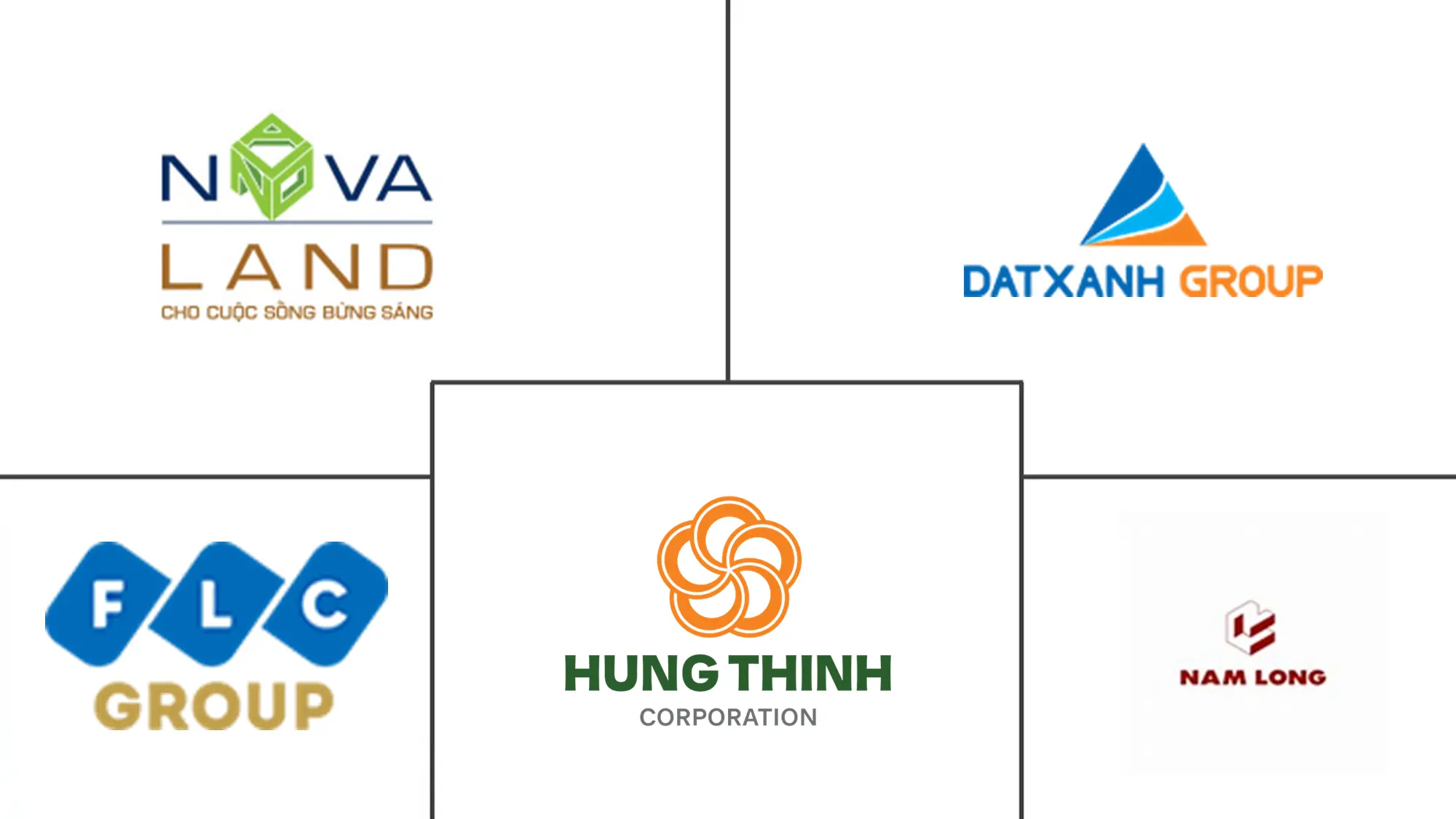
*Disclaimer: Major Players sorted in no particular order |
Vietnam Residential Real Estate Market Analysis
The Vietnam Residential Real Estate Market size is estimated at USD 28.43 billion in 2025, and is expected to reach USD 51.35 billion by 2030, at a CAGR of 12.55% during the forecast period (2025-2030).
- The growth in the Vietnamese population is driving the demand for new housing units, thereby supporting the growth of the residential construction market in the Southeast Asian market. Notably, the population is projected to further increase over the next few years in Vietnam. Vietnam's population is equivalent to 1.23% of the total world population.
- According to the Ministry of Construction, the urban population proportion is at more than 40% currently and is projected to reach 45% by 2030. As a result of this growth in proportion, Vietnam will have to add another 70 million square meters of housing every year.
- Over the next three to four years, Vietnam is expected to experience a high demand growth for housing units in big cities and industrial zones. This growth in demand will keep assisting the growth of the residential construction segment, as well as the growth of the overall construction market, from the short to medium-term perspective.
- Vietnam, across various sectors, including construction and real estate, is rising with great potential among the Southeast Asian economies and is expected to continue its stellar growth in the coming years. The outlook for the Vietnamese residential real estate market is buoyant, mainly due to continued strong economic growth, rapid urbanization growth, and the construction of several mega projects in major cities such as Ho Chi Minh and Hanoi.
- The rising internet penetration and increase in disposable income by the middle-class youth population in Vietnam have surged the demand and sales proportion of residential real estate through online channels. This quick surge in individual wealth has made property affordable for many Vietnamese people, contributing to an increase in new developments and property prices.
- The residential market's focus has shifted from the high-end to the mid-value segments as urbanization has created an ongoing demand for housing in large urban centers. Furthermore, the country is now widely seen as the luxury real estate market hotspot, with a growing economy coupled with laws that have made it easier for foreigners to purchase the property.
- In Q4 2022, the successful transaction volume for condominiums and individual houses was 14,349 transactions (approximately 28% compared to Q3/2022), including 3,821 transactions in the North, 5,968 transactions in the Central region, and 4,560 transactions in the South. Specifically, there were 454 successful transactions in Hanoi and 1,986 successful transactions in Ho Chi Minh City. In Q4 2022, the successful transaction volume for land plots is 149,197 transactions (approximately 130% compared to Q3/2022), including 29,402 transactions in the North, 32,579 transactions in the Central region, and 87,216 successful transactions in the South.
Vietnam Residential Real Estate Market Trends
Rising Government Initiatives and Social Housing Development Policies
- The National Assembly and the Government of Vietnam propagated many policies and mechanisms to develop social housing to support disadvantaged and low-income people in urban and rural areas. The Vietnamese government's key initiatives include the housing law and other official directives to provide support and incentives for the development and management of social housing. It also has openness for investment by foreign individuals and organizations in social housing development.
- HCMC council implemented projects to increase the sources of pure land in urban and suburban areas and retrieved about 200 hectares (initially in 2008) of the site from the inner city to the suburban. The expansion of the availability of clean land is likely to increase the radius of social housing from the central area.
- According to the MoC, most social housing projects would be implemented in areas with large industrial parks, including Long An (310,000 units), Bac Giang (285,000), Bac Ninh (96,2 7), and Binh Duong (8,000). Social housing projects are also considered a priority in large urban cities such as Hanoi (136,000 apartments), Ho Chi Minh City (130,000), Haiphong ( 5,355), and Danang (19,360). KM assumed the implementation of the plan in stages, when approximately 700,000 apartments should be completed in the period 2021-2025, i.e., 5 % of the total demand, and 1.1 million apartments in 2025-2030, i.e., 85%.
Rapid Urbanization is Supplementing Housing Demand
- Urbanization will be an important driving force for rapid and sustainable socio-economic development in the future, and urban areas will make up the largest part of the country's economy in the coming years. All party committees and party members are therefore called to focus on the planning, construction, management, and sustainability of Vietnam's urban areas by 2030.
- The resolution also sets specific targets, such as the rate of urbanization reaching at least 5 percent by 2025 and more than 50 percent by 2030. in the country by 2025 and around 1.9-2.3 percent by 2030. The nationwide number of built-in areas will reach 950-1000 by 2025 and approximately 1000-1200 by 2030.
- The share of the urban economy in the gross domestic product will be about 75 percent by 2025. 85 percent by 2030. In addition, the level of urbanization in ASEAN and Asia is estimated to be medium to high by 2045.
Vietnam Residential Real Estate Industry Overview
The Vietnamese residential real estate market is fragmented due to many local and global players' presence. Vietnam residential real estate includes:
Pure Vietnamese capital-based local companies.
Foreign investment funds from foreign companies.
Joint venture firms.
Various proptech startups and traditional real estate firms aim to leverage technology to improve their operations and competitive edge by providing practical solutions. It enhances home buying, selling, renting, and living experiences in Vietnam.
Key players in the residential real estate market include Novaland Group, Dat Xanh Group, FLC Group, Hung Thinh Real Estate Business Investment Corporation, and Nam Long Investment Corporation.
Vietnam Residential Real Estate Market Leaders
-
Novaland Group
-
Dat Xanh Group
-
Nam Long Investment Corporation
-
Hung Thinh Real Estate Business Investment Corporation
-
FLC Group
- *Disclaimer: Major Players sorted in no particular order
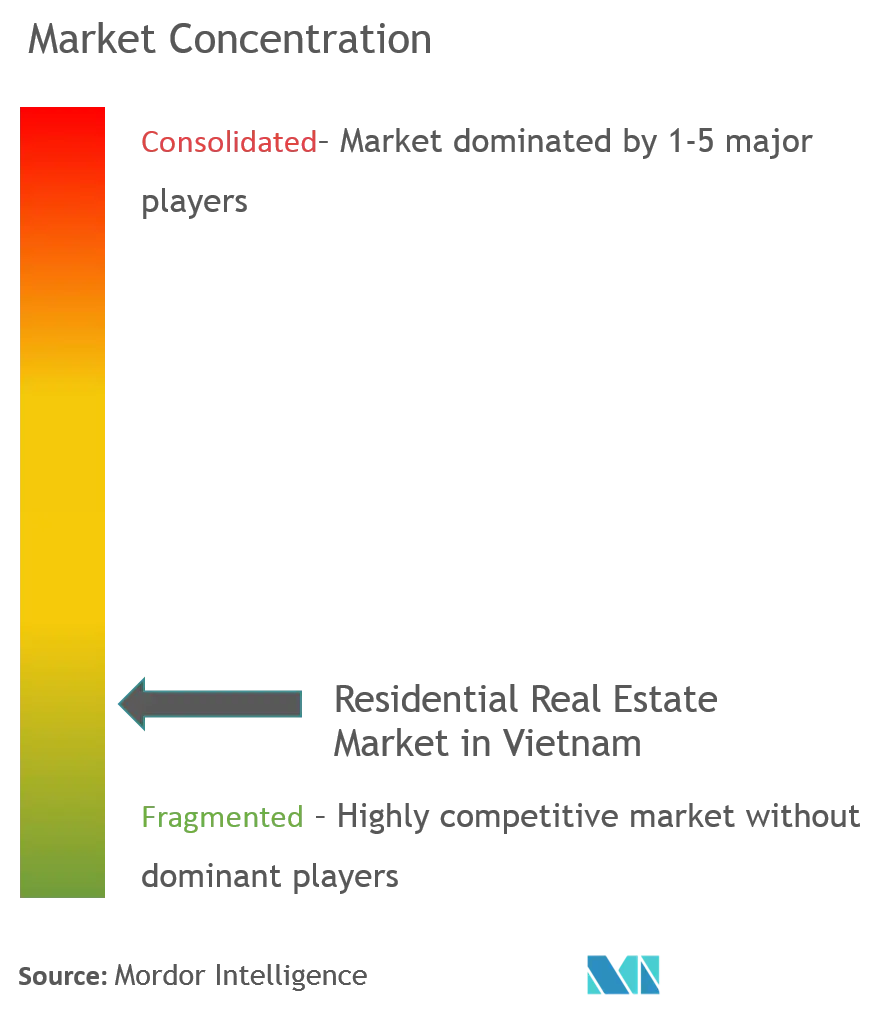
Vietnam Residential Real Estate Market News
- November 2023: Phat Dat Real Estate Development Joint Stock Company and Military Commercial Joint Stock Bank (MB Bank) signed a comprehensive cooperation agreement with the purpose of financial sponsorship for investors and customers. Products at Phat Dat projects. The sponsored project is the Thuan An 1&2 high-rise housing complex with a scale of 4.47 hectares, located in a prime location right in the central area of Thuan An City, connected to many large industrial clusters in Binh Duong. The project has completed its legality with an investment of more than 10,800 billion VND, including apartment products, shophouses, and townhouses.
- October 2023: Phat Dat's investment project of more than 10,000 billion in Binh Duong has been approved for planning. Phat Dat's investment project of more than 10,000 billion in Binh Duong has been approved for planning.
Vietnam Residential Real Estate Industry Segmentation
Residential real estate is broadly defined as real property (land and any buildings) used for residential purposes.
The report provides a comprehensive background analysis of the Canadian facade market, covering the current market trends, restraints, technological updates, and detailed information on various segments and the competitive landscape of the industry. Additionally, the COVID-19 impact has been incorporated and considered during the study. The Vietnam residential real estate market is segmented by type (villas and landed houses and condominiums and apartments) and by city (Ho Chi Minh City, Hanoi, Danang, Quang Ninh, and the rest of Vietnam).
The report offers market size and forecasts for the Vietnamese residential real estate market in value (USD) for all the above segments.
| By Type | Apartments and Condominiums |
| Villas and Landed Houses | |
| By Key Cities | Ho Chi Minh City |
| Hanoi | |
| Danang |
Vietnam Residential Real Estate Market Research FAQs
How big is the Vietnam Residential Real Estate Market?
The Vietnam Residential Real Estate Market size is expected to reach USD 28.43 billion in 2025 and grow at a CAGR of 12.55% to reach USD 51.35 billion by 2030.
What is the current Vietnam Residential Real Estate Market size?
In 2025, the Vietnam Residential Real Estate Market size is expected to reach USD 28.43 billion.
Who are the key players in Vietnam Residential Real Estate Market?
Novaland Group, Dat Xanh Group, Nam Long Investment Corporation, Hung Thinh Real Estate Business Investment Corporation and FLC Group are the major companies operating in the Vietnam Residential Real Estate Market.
What years does this Vietnam Residential Real Estate Market cover, and what was the market size in 2024?
In 2024, the Vietnam Residential Real Estate Market size was estimated at USD 24.86 billion. The report covers the Vietnam Residential Real Estate Market historical market size for years: 2020, 2021, 2022, 2023 and 2024. The report also forecasts the Vietnam Residential Real Estate Market size for years: 2025, 2026, 2027, 2028, 2029 and 2030.
Our Best Selling Reports
Vietnam Residential Real Estate Industry Report
The Vietnam residential real estate market is experiencing robust growth driven by rapid urbanization and an expanding middle class. This market is segmented into apartments and condominiums, as well as villas and landed houses, catering to diverse consumer preferences. High-rise apartments and condominiums are increasingly popular in urban areas due to limited land availability, while integrated residential projects that combine residential, commercial, and recreational spaces are on the rise. These developments offer modern amenities and a holistic living experience, appealing to both local and foreign buyers.
The market benefits from favorable macroeconomic factors such as stable economic growth and low interest rates, enhancing its attractiveness for real estate investments. Government initiatives promoting social housing and favorable policies for foreign ownership further stimulate market expansion. Additionally, the demand for smart, eco-friendly homes is increasing, reflecting a growing awareness of environmental health and sustainability.
Market predictions indicate a positive market outlook for Vietnam's residential real estate sector. The market size is expected to grow, supported by detailed market analysis and market forecast reports. Market segmentation highlights the diverse offerings within the sector, catering to various consumer needs. The market report provides comprehensive market research, including price trends and sales data, essential for understanding the target market dynamics.
Industry analysis reveals that the industry's growth rate is supported by favorable market data and market growth trends. Industry reports and industry research provide insights into market leaders and their strategies. The market overview and market review offer a detailed market value assessment, while the market outlook and market predictions provide a forward-looking perspective on the sector's potential.
In summary, Vietnam's residential real estate market is poised for continued expansion, offering various opportunities for investors and developers. For more insights, a report pdf is available that includes detailed research companies' information and a report example.



